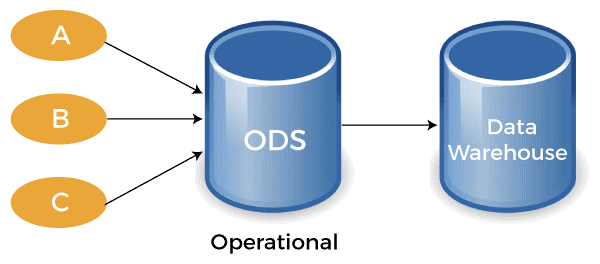Operational Data Store ODS
Explanation: Operational datastore is a temporary database that kept the integrated data from multiple sources, and temporary operations are applied to data. Unlike a master data store, the data is not passed back to the operational system. It may be passed for further operations and to the data warehouse for reporting. The operational data store is a source to a data warehouse.
The integrated data from multiple sources involves cleaning, removing duplicate records, and checking against multiple business rules for data quality or integrity.
An ODS is usually designed to contain atomic data such as transactions and limited history captured in real-time or near real-time. However, that information is presented in the data warehouse. That's why ODS is a source to the data warehouse.
The general general-purpose of an operational data store is to integrate data from multiple different sources into a single structure using ETL technologies that provide operational reporting of the data by applying operational access to the data and master data management or reference data management. ODS, in turn, is a source to the data warehouse rather than a replacement or substitute for the database.
Data is kept temporarily in ODS that reduces the contention to the OLTP systems and does not update the data warehouse frequently because the data warehouse is not supposed to update with real-time operations daily.

Benefits of Operational Data Store
- The ODS applies only to the world of operating systems because the source of ODS is only online transaction processing or operational data.
- The ODS contains real or near real-time datastated as current or near current value as little as possible.
- The ODS contains almost all the data in detail. For example, thousands of tables are present in the data warehouse.
- The ODS requires an updated, fully functioned, and record-oriented environment. Any record updation that happens will be done to ODS. Also, if there are any changes based on business logic, it has to act on it based on business logic that also involves updates. It's not that it only takes the inserts, and if there is any change to the record, it will not insert it again. It will identify it and update the record.
Functions of an ODS
- Converts data
- Decides which data of multiple sources is the best.
- Decodes/ encodes data
- Alters the key structures
- Alter the physical structures
- Reformats data
- Internally represents data
- Recalculated data
The main difference between ODS and data warehouse is that the number of days of data present in the ODS is less and doesn't contain historical data.
Staging area Vs. ODS
With the help of ETL tool extraction, transformation and loading are applied to data. It is moved to a staging area where operations/queries are applied on the data tables that are temporarily stored for many days/ weeks/ months and many more. The staging area is similar to ODS or vice versa as both can store the integrated files from multiple sources.
ODS is the initial database of a start-up enterprise for storing the data. Starting an enterprise can't afford data warehouse capacity. They also have a small amount of data that ODS can handle with ease.
When the business of an enterprise succeeded and data increases, they need a permanent data warehouse that can handle a large amount of data and operational queries on multiple data tables.
Therefore ODS is a staging area that stores operational data as temporarily relational data for a certain period.
The staging area is important in the data warehouse.
The staging area in data warehouse architecture completely depends on the kindof data coming from multiple sources. The staging area is the phase in data warehouse architecture that holds the data or data tables are created temporarily on the data warehouse server. The staging area is needed to hold data, perform data cleansing and merging before loading the data into the data warehouse.
The above image has different data sources: flat files, Oracle database, XML, an application, and an operational system. With the help of the ETL tool, data is loaded, and a staging area is created. Staging areas have converted conventional data into relational data, and on that, you can apply validation, apply data cleansing/ scrubbing, data quality checks, or something according to business requirements. After doing this, data is put in the data warehouse (permanent relational database) from where business intelligence started.
Therefore, the staging area act as a source in data warehouse architecture. The staging area is a temporary location/ relational location. Data is held to perform cleansing and merge or validate any basic data quality rules before loading the data into the data warehouse.
The main advantage of using the stating area is that all the data from different sources is temporarily converted into one format. Applying logic and validation became easy in the staging area.
For example: If you have to verify @ simple in the different kinds of sources that are available here, there are different logic for each source, but after loading data in the staging area, you have to write only one function to verify @ simple and validate the record.
The one disadvantage of staging is the redundancy. Data will be redundant as it creates a copy of data, and to avoid that staging area, it is called the temporary data holder.
The frequency of cleaning the data is the trinket load where all the data is trinket and load it or data is kept for one month, then run, six months (it depends on the ETL architect) or how business requirement looks around the data.